Geimhreadh (Nollaig 2022, Eanáir & Feabhra 2023)
Tús fuar, séimh agus tirim ar an iomlán
Sa chéad leath de mhí na Nollag 2022, bhí aermhaiseanna Artacha an-fhuar ann den chuid is mó, agus bhí ardbhrú amach ón tuaisceart agus bhí an Scairdsruth díláithrithe i bhfad amach ó dheisceart na hÉireann, rud a d’fhág go raibh dálaí ní ba thirime ná an meán agus Ascalú diúltach an Atlantaigh Thuaidh ann. Ní raibh an dara leath de mhí na Nollag chomh fuar, agus córais lagbhrú an Atlantaigh i bhfeidhm ag tabhairt dálaí níos fliche ná an meán de réir mar a d’éirigh Ascalú an Atlantaigh Thuaidh dearfach agus d’fhan sé dearfach ar feadh an chuid eile den gheimhreadh. Bhí an chéad leath de mhí Eanáir 2023 séimh, fliuch agus gaofar go minic, le córais lagbhrú an Atlantaigh amach ón iarthar agus ón iarthuaisceart ag stiúradh roinnt frontaí aimsire ar fud na tíre. Bhí an dara leath den mhí i bhfad níos tirime, go háirithe san Oirthear. Thug gaoth fhuar ón tuaisceart sneachta in áiteanna ar dtús, sular bhog aer níos séimhe isteach ón iarthar agus ardbhrú ag forbairt amach ón deisceart. Bhí smacht ag an ardbhrú le linn formhór de mhí Feabhra, rud a thug dálaí séimhe agus an-tirim den chuid is mó ar fud na tíre leis. Ní raibh aon stoirmeacha ainmnithe a raibh tionchar acu ar Éirinn i rith gheimhreadh 2022/23. Thosaigh téamh tobann strataisféarach Déardaoin an 16 Feabhra, ach tharla sé rómhall chun tionchar a imirt ar aimsir an gheimhridh.
Báisteach: Faoin meán beagnach i ngach áit; ba é an tOirthear an áit ba thirime
Ní raibh ach iomlán séasúrach titime báistí amháin os cionn a Mheánleibhéil Fhadtéarmaigh (MLFT) 1981-2010. Bhí an céatadán luachanna titime báistí séasúracha idir 67% (titim báistí shéasúrach de 148.4mm san iomlán) ag Baile an Phaghanaigh, Co. Cheatharlach go 105% (titim báistí shéasúrach 388.4mm san iomlán) ag Béal an Mhuirthead, Co. Mhaigh Eo. Bhí na hiomláin titime báistí séasúracha don séasúr idir 131.4 mm (71% dá MLFT) ag Aerfort Bhaile Átha Cliath agus 429.4 mm (91% dá MLFT) ag Baile Uí Fhiacháin, Co. Mhaigh Eo. Ba é an t-iomlán titime báistí laethúil is airde ná 41.3 mm ag Béal an Mhuirthead, Co. Mhaigh Eo ar Lá Nollag, Dé Domhnaigh an 25 Nollaig. Bhí líon na laethanta báistí idir 43 lá ag Baile an Phaghanaigh, Co. Cheatharlach agus 75 lá ag Béal an Mhuirthead, Co. Mhaigh Eo. Bhí líon na laethanta fliucha idir 29 lá ag Páirc an Fhionnuisce, Co. Bhaile Átha Cliath agus Baile an Phaghanaigh, Co. Cheatharlach agus 59 lá ag Béal an Mhuirthead, Co. Mhaigh Eo. Mhéadaigh líon na laethanta an-fhliuch ó 3 lá ag cúpla stáisiún go 17 lá ag Réadlann Dhairbhre, Co. Chiarraí. Bhí sealanna tirime ag cúig stáisiún idir Dé Domhnaigh an 27 Samhain agus Dé Domhnaigh an 18 Nollaig, a mhair idir 15 agus 22 lá. Ba iad seo Baile Átha hÉis, Co. an Chabháin (22 lá), Aerfort na Sionainne, Co. an Chláir (18 lá), An Chloch Liath, Co. Chorcaí (16 lá), Clár Chlainne Mhuiris agus Aerfort Chnoc Mhuire, Co. Mhaigh Eo (15 lá). Bhí sealanna tirime ag naoi stáisiún idir Dé Luain an 16 Eanáir agus Dé Máirt an 14 Feabhra, a mhair idir 16 agus 30 lá. Ba ag na stáisiúin seo a leanas a bhí siad: Aerfort Bhaile Átha Cliath, Co. Bhaile Átha Cliath, Dún Samhnaí, Co. na Mí (30 lá), Caisleán Bhaile Sheáin, Co. Loch Garman (22 lá), Rinn an Róistigh, Co. Chorcaí (21 lá), Aeradróm Mhic Easmainn, Co. Bhaile Átha Cliath (20 lá), Páirc an Fhionnuisce, Co. Bhaile Átha Cliath (19 lá), An Chloch Liath, Co. Chorcaí, Baile an Phaghanaigh, Co. Cheatharlach agus Aerfort na Sionainne, Co. an Chláir (16 lá). Bhí dearbhthriomach amháin i gCaisleán Bhaile Sheáin, Co. Loch Garman idir Dé Céadaoin an 25 Eanáir agus Déardaoin an 9 Feabhra, a mhair 16 lá. Bhí dhá pháirt-triomach ag Aerfort Bhaile Átha Cliath (31 lá) agus Páirc an Fhionnuisce, Co. Bhaile Átha Cliath (30 lá) idir Dé Sathairn an 14 Eanáir agus Dé Máirt an 14 Feabhra.
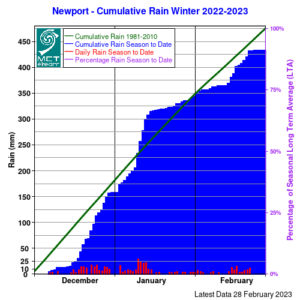
Graf titime báistí Bhaile Uí Fhiacháin, Co. Mhaigh Eo don gheimhreadh 2022/23.
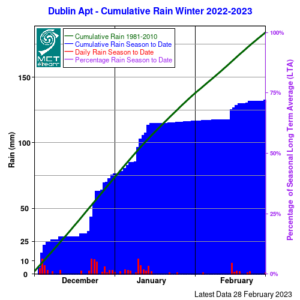
Graf titime báistí Aerfort Bhaile Átha Cliath don gheimhreadh 2022/23
Teocht: Os cionn an mheáin i mbeagnach gach áit, bhí na teochtaí is airde san Iardheisceart
Ní raibh ach stáisiún amháin ina raibh meánteocht an aeir faoi bhun na gnáth-theochta don séasúr. Bhí athruithe ó mheánteocht an aeir idir -0.3 °C (meánteocht 5.2 °C) ag Marcréidh, Co. Shligigh agus 0.9 °C (6.1 °C meánteocht) ag Páirc an Fhionnuisce, Co. Bhaile Átha Cliath. Bhí meánteochtaí an tséasúir idir 4.9 °C (0.7 °C os cionn a MLFT) ag Aerfort Chnoc Mhuire, Co. Mhaigh Eo agus 7.8 °C (0.1 °C os cionn a MLFT) ag Inis Arcáin, Co. Chorcaí. Tuairiscíodh an teocht is airde den séasúr ag Páirc an Fhionnuisce, Co. Bhaile Átha Cliath Dé Mháirt an 14 Feabhra agus bhí teocht 15.9 °C ann. Taifeadadh íosteocht aeir an tséasúir agus an íosteocht féir is ísle ag Cluain Creamha, Co. Ros Comáin. Tuairiscíodh an teocht aeir is ísle Dé hAoine an 16 Nollaig ag -8.8 °C (an teocht is ísle in Éirinn ó mhí na Nollag 2010), agus tuairiscíodh an íosteocht féir is ísle ag -13.0 °C Dé Céadaoin an 14 Nollaig. Tuairiscíodh sioc aeir agus talún i rith an tséasúir ag gach stáisiún. Ba é líon na laethanta nuair a bhí sioc talún ann ná 16 lá ag Inis Arcáin, Co. Chorcaí go 57 lá ag Marcréidh, Co. Shligigh. Ba é líon na laethanta nuair a bhí sioc aeir ann ná 6 lá ag Rinn an Róistigh, Co. Chorcaí go 27 lá ag Cluain Creamha, Co. Ros Comáin.
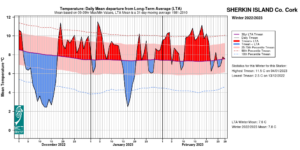
Teocht ag Inis Arcáin, Co. Chorcaí: Meánimeacht laethúil ó MLFT don gheimhreadh 2022/23.
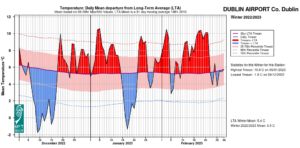
Teocht ag Aerfort Bhaile Átha Cliath: Meánimeacht laethúil ó MLFT don gheimhreadh 2022/23.
Taitneamh gréine: Taitneamh gréine ba ghrianmhaire sa Deisceart agus san Oirthear
Bhí na hiomláin taitnimh gréine ar fad a bhí ar fáil os cionn an Mheánleibhéil Fhadtéarmaigh (MLFT) don séasúr. Bhí céatadán na luachanna taitnimh gréine séasúracha idir 112% (iomlán taitnimh gréine séasúrach de 181.0 uair an chloig) ag Aerfort na Sionainne, Co. an Chláir agus 118% (iomlán taitnimh gréine séasúrach de 204.2 uair an chloig) ag Aeradróm Mhic Easmainn, Co. Bhaile Átha Cliath. Bhí na hiomláin taitnimh gréine shéasúracha idir 129.2 uair an chloig (Níl comparáid MLFT ar fáil*) ag Cionn Mhálanna, Co. Dhún na nGall agus 236.0 uair an chloig (Níl comparáid MLFT ar fáil*) ag Aerfort Bhaile Átha Cliath, Co. Bhaile Átha Cliath. Ba é an líon is airde uaireanta gréine laethúil a taifeadadh an séasúr seo ná 9.5 uair ag Béal an Mhuirthead, Co. Mhaigh Eo ar an Luan 27 Feabhra. Bhí líon na laethanta gruama idir 22 lá ag Caisleán Bhaile Sheáin, Co. Loch Garman agus 41 lá ag Réadlann Dhairbhre, Co. Chiarraí.
Gaoth: Tuairiscíodh gaotha fórsa stoirme, gan aon stoirmeacha ainmnithe>
Bhí an meánluas séasúrach gaoithe idir 5.7 muirmhíle san uair (10.6 km/u) ag an gCloch Liath, Co. Chorcaí agus 16.4 muirmhíle san uair (30.4 km/u) ag Cionn Mhálanna, Co. Dhún na nGall. Tugadh tuairisc ar ghálaí ar roinnt laethanta, agus tuairiscíodh gálaí nach mó ná láidre ar an 7, an 11, an 14, an 15 Eanáir agus an 21 Nollaig. Tuairiscíodh gaotha fórsa stoirme Déardaoin an 12 Eanáir. Bhí líon na laethanta le gálaí idir lá ar bith ag cúpla stáisiún agus 17 lá ag Cionn Mhálanna, Co. Dhún na nGall. Bhí líon na laethanta le gaoth nach mó ná gálaí láidre idir lá ar bith ag formhór na stáisiún agus 4 lá ag Ceann Mhása, Co. na Gaillimhe. Tuairiscíodh an séideán is airde sa séasúr agus meánluas na gaoithe 10 nóiméad ag Ceann Mhása, Co na Gaillimhe Déardaoin an 12 Eanáir. Ba é an séideán is airde ná 66 muirmhíle san uair (122 km/u) agus ba é an luas gaoithe 10 nóiméad is airde ná 48 muirmhíle (89 km/u).
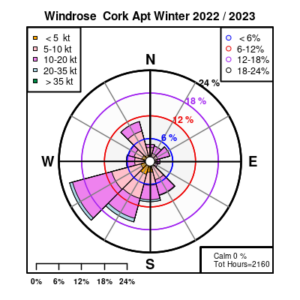
D’ardaigh an tUasmhéid Gaoithe Marthanaí (meán 10-nóiméad) d’Aerfort Chorcaí le linn gheimhreadh 2022/23 (sealadach).
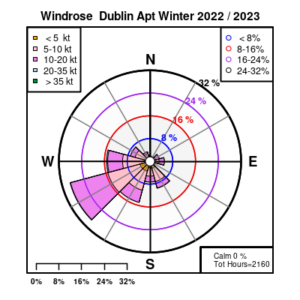
D’ardaigh an tUasmhéid Gaoithe Marthanaí (meán 10-nóiméad) d’Aerfort Bhaile Átha Cliath le linn gheimhreadh 2022/23 (sealadach).
Tá an tuarascáil iomlán ar fáil anseo (roghnaigh geimhreadh sa roghchlár anuas don mhí).
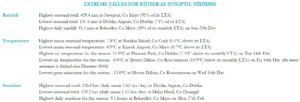
Winter 2022/23 extreme values at synoptic stations
Feabhra 2023
An-séimh agus an-tirim
Bhí ardbhrú i dtreis ar feadh formhór mhí Feabhra 2023, rud a thug dálaí an-séimh agus an-tirim ar fud na tíre. Le linn na chéad seachtaine, thug ardbhrú, a bhí lonnaithe amach ó dheisceart na hÉireann, coinníollacha tirime den chuid is mó ach sách scamallach in aershreabh aneas agus aniar. Thrasnaigh cúpla fronta aimsire laga an tír ón iarthar ach d’fhan méideanna titime báistí íseal, go háirithe sa Deisceart agus san Oirthear. Le linn an dara seachtain, d’fhorbair ardbhrú amach ó dheisceart na hÉireann, a thug aershreabh aneas leis. D’fhan sé séimh agus tirim den chuid is mó, seachas fronta aimsire lag ag trasnú na tíre ar an 8 Feabhra agus roinnt báistí nó ceathanna ar an 14 Feabhra. Le linn an tríú seachtain, d’éirigh na dálaí aimsire i bhfad níos claochlaithí de réir mar a tháinig frontaí aimsire Atlantacha isteach ón iarthar, rud a thug báisteach nó ceathanna leo ar fhormhór na laethanta. D’fhan an t-ardbhrú gar don deisceart, rud ba chúis leis an titim báistí íseal, go háirithe sa Deisceart agus san Oirthear arís. Thosaigh an ceathrú seachtain le báisteach nó ceathanna scaipthe ar fud na tíre ar an 22 Feabhra, sular fhorbair ardbhrú os cionn na hÉireann ón iarthar agus a bhí i réim don chuid eile den tseachtain, rud a raibh aimsir thirim mar thoradh air den chuid is mó. Bhí sé níos fuaire de réir mar a d’fhorbair aershreabh anoir, le go leor gréine san Iarthar ach níos scamallaí san Oirthear.
Báisteach: Faoin meán i ngach áit, an Deisceart agus an Oirthear na háiteanna ba thirime
Bhí na hiomláin titime báistí mhíosúla ar fud na tíre don mhí faoina Meánleibhéal Fadtréimhseach 1981-2010 (MLFT). Bhí an céatadán de luachanna titime báistí míosúla idir 10% (an t-iomlán titime báistí míosúil is ísle na míosa ag 7.4mm) ag Caisleán Bhaile Sheáin, Co. Loch Garman (an Fheabhra is tirime ó 1986) agus 72% (an t-iomlán titime báistí míosúil is airde na míosa ag 91.6mm) ag Baile Uí Fhiacháin, Co. Mhaigh Eo (an Fheabhra is tirime ó 2013). Ba é an t-iomlán titime báistí laethúil ab airde ná 17.0 mm ag Réadlann Dhairbhre, Co. Chiarraí Dé Céadaoin an 15 Feabhra. Bhí líon na laethanta báistí idir 8 lá ag Caisleán Bhaile Sheáin, Co. Loch Garman agus 20 lá ag roinnt stáisiún. Bhí líon na laethanta fliucha idir 2 lá ag Rinn an Róistigh, Co. Chorcaí agus Caisleán Bhaile Sheáin, Co. Loch Garman, agus 16 lá ag Marcréidh, Co. Shligigh agus Aerfort Chnoc Mhuire, Co. Mhaigh Eo. Bhí líon na laethanta iontach fliuch idir lá ar bith ag cúpla stáisiún agus 3 lá ag Baile Uí Fhiacháin, Co. Mhaigh Eo. Bhí sealanna tirime ag naoi stáisiún idir Dé Luain an 16 Eanáir agus Dé Máirt an 14 Feabhra, a mhair idir 16 agus 30 lá. Ba ag na stáisiúin seo a leanas a bhíodar: Aerfort Bhaile Átha Cliath, Co. Bhaile Átha Cliath, Dún Samhnaí, Co. na Mí (30 lá), Caisleán Bhaile Sheáin, Co. Loch Garman (22 lá), Rinn an Róistigh, Co. Chorcaí (21 lá), Aeradróm Mhic Easmainn, Co. Bhaile Átha Cliath (20 lá), Páirc an Fhionnuisce, Co. Bhaile Átha Cliath (19 lá), An Chloch Liath, Co. Chorcaí, Baile an Phaghanaigh, Co. Cheatharlach agus Aerfort na Sionainne, Co. an Chláir (16 lá). Bhí dearbhthriomach amháin i gCaisleán Bhaile Sheáin, Co. Loch Garman idir Dé Céadaoin an 25 Eanáir agus Déardaoin an 9 Feabhra, a mhair 16 lá. Bhí dhá pháirt-triomach ag Aerfort Bhaile Átha Cliath (31 lá) agus Páirc an Fhionnuisce, Co. Bhaile Átha Cliath (30 lá) idir Dé Sathairn an 14 Eanáir agus Dé Máirt an 14 Feabhra. Ba é seo an Fheabhra ba thirime ó 1965 i nDún Samhnaí, Co. na Mí agus i bPáirc an Fhionnuisce, Co. Bhaile Átha Cliath. Ba é an Fheabhra ba thirime ó 1986 i mbaile an Phaghanaigh, Co. Cheatharlach, i gCaisleán Bhaile Sheáin, Co. Loch Garman agus in Aerfort Chorcaí, Co. Chorcaí.
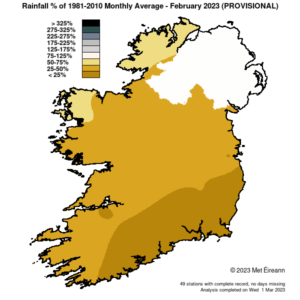
% titim báistí 1981 – 2010 Meán Míosúil do mhí Feabhra 2023 (Sealadach).
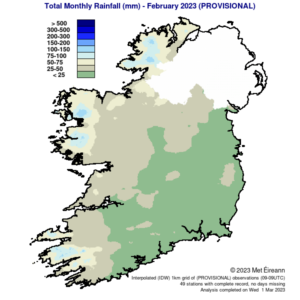
Titim Báistí Mhíosúil Iomlán (mm) do mhí Feabhra 2023 (Sealadach). (Provisional)
Teocht: Os cionn an mheáin i ngach áit
Bhí meánteocht an aeir ar fud na tíre os cionn an MLFT don mhí. Bhí na hathruithe ó mheánteocht an aeir idir 1.3 °C (8.8 °C mheánteocht) ag Inis Shearcáin, Co. Chorcaí go 2.4 °C ag an dá cheann i bhFionnúir, Co. Dhún na nGall agus ag Páirc an Fhionnuisce, Co. Bhaile Átha Cliath (7.8 °C agus 7.6 °C an mheánteocht faoi seach). Bhí meánteochtaí na míosa idir 6.5 °C (2.3 °C os cionn a MLFT) ag Aerfort Chnoc Mhuire, Co. Mhaigh Eo agus 8.9 °C (1.6 °C os cionn a MLFT) ag Réadlann Dhairbhre, Co. Chiarraí. Taifeadadh na teochtaí ab ísle sa mhí Dé Domhnaigh an 5 Feabhra agus tuairiscíodh an íosteocht aeir ab ísle i Muileann gCearr, Co. na hIarmhí le teocht -4.3 °C agus an íosteocht féir ab ísle a tuairiscíodh ag Baile an Phaghanaigh, Co. Cheatharlach le -9.3 °C. Tuairiscíodh an uasteocht is airde ar De Máirt, an 14 Feabhra, ag Páirc an Fhionnuisce, Co. Bhaile Átha Cliath, le teocht de 15.9 °C. Thuairiscigh gach stáisiún sioc talún i rith na míosa. Ba é líon na laethanta nuair a bhí sioc talún ann ná 1 lá ag Inis Arcáin, Co. Chorcaí go 13 lá ag Muileann gCearr, Co. na hIarmhí. Thuairiscigh níos mó ná leath na stáisiún sioc aeir. Bhí líon na laethanta inar taifeadadh sioc aeir idir lá ar bith ag Ceann Mhása, Co. na Gaillimhe agus 6 lá ag Marcréidh, Co. Shligigh agus ag Goirtín, Co. Thiobraid Árann.
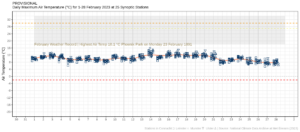
Highest screen air temperatures observed at each station each day during February 2023
Taitneamh gréine: Gruama ar an iomlán, an t-oirdheisceart an réigiún ba ghrianmhaire
Bhí beagnach gach iomlán taitnimh gréine a bhí ar fáil faoin MLFT. Bhí céatadán na luachanna taitnimh gréine míosúla idir 90% (iomlán taitnimh gréine míosúil de 64.2 uair an chloig) ag Aeradróm Mhic Easmainn, Co. Bhaile Átha Cliath agus 96% (iomlán taitnimh gréine míosúil de 62.7 uair an chloig) ag Aerfort na Sionainne, Co. an Chláir. Bhí na hiomláin taitnimh gréine mhíosúla idir 45.0 uair an chloig (Níl comparáid MLFT ar fáil*) ag Réadlann Dhairbhre, Co. Chiarraí agus 72.0 uair an chloig (Níl comparáid MLFT ar fáil*) ag Caisleán Bhaile Sheáin, Co. Loch Garman. Ba é an líon is airde uaireanta gréine laethúil a taifeadadh an mhí seo ná 9.5 uair ag Béal an Mhuirthead, Co. Mhaigh Eo ar Luan an 27 Feabhra. Bhí líon na laethanta gruama idir 5 lá ag Caisleán Bhaile Sheáin, Co. Loch Garman agus 14 lá ag Réadlann Dhairbhre, Co. Chiarraí.
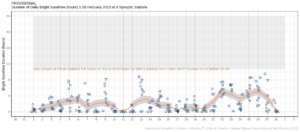
Uaireanta gréine geala a tugadh faoi deara ag gach stáisiún do gach lá den mhí, curtha le chéile de réir cúige do mhí Feabhra 2023
Gaoth: Tuairiscíodh gálaí
Bhí an meánluas gaoithe míosúil idir 5.7 muirmhíle san uair (10.6 km/u) ag an gCloch Liath, Co. Chorcaí agus 16.4 muirmhíle san uair (30.4 km/u) ag Cionn Mhálanna, Co. Dhún na nGall. Tuairiscíodh gálaí Dé Céadaoin an 8, Déardaoin an 16 agus Dé hAoine an 17 Feabhra. Bhí líon na laethanta le gaotha fórsa gála idir lá ar bith ag an gcuid is mó de na stáisiúin go dtí trí lá ag Cionn Mhálanna, Co. Dún na nGall. Níor tuairiscíodh aon ghála láidir ná gaotha níos airde an mhí seo. Tuairiscíodh an séideán is airde agus an meánluas gaoithe 10 nóiméad is airde sa mhí ag Cionn Mhálanna, Co. Dún na nGall. Ba é an séideán is airde ná 52 muirmhíle san uair (96 km/u) Dé Céadaoin an 8 agus Dé hAoine an 17 Feabhra agus ba é an meánluas gaoithe 10 nóiméad is airde ná 40 muirmhíle (74 km/u) Dé hAoine an 17 Feabhra.
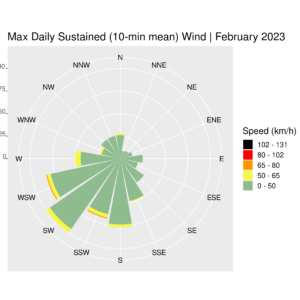
D’ardaigh an tUasmhéid Gaoithe Marthanaí (meán 10-nóiméad) d’Éirinn le linn Feabhra 2023 (sealadach)
The full report is available here
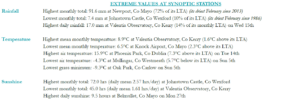
February 2023 extreme values at synoptic stations
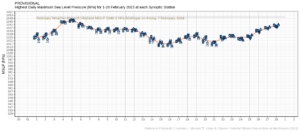
An meánbhrú ag leibhéal na farraige (MBLF) laethúil is airde a tugadh faoi deara ag gach stáisiún a bhí ar fáil d’Fheabhra 2023
Mí Feabhra le Cúpla Bliain Anuas in Éirinn:
- 2016: Thuairiscigh beagnach gach stáisiún os cionn a Meánleibhéil Fhadtéarmaigh (MLFT) maidir le báisteach agus faoina bhun maidir le meánteochtaí. Bhí na hiomláin taitneamh gréine os cionn an mheáin sa Deisceart agus san Oirthear. Thug Stoirm Henry agus Imogen gaotha neart stoirme leo.
- 2017: Bhí leath de na hiomláin titime báistí faoi bhun an mheáin. Bhí meánteocht an aeir os cionn an mheáin, bhí an taitneamh gréine faoi bhun, agus thug Stoirm Doris na gaotha is airde den mhí.
- 2018: Bhí beagnach gach stáisiún faoi bhun an mheáin maidir leis na hiomláin titime báistí míosúla ar fad agus bhí meánteochtaí aeir ar fad faoi bhun an mheáin agus bhí na hiomláin taitnimh gréine os cionn an mheáin.
- 2019: Bhí beagnach gach iomláin titime báistí faoi bhun an mheáin agus bhí meánteochtaí aeir ar fad os cionn an mheáin agus na hiomláin taitnimh gréine athraitheach. Thug Stoirm Erik gaotha fórsa stoirme go dtí an tIarthar ar an 8 Feabhra.
- 2020: Bhí na hiomláin titime báistí ar fad i bhfad os cionn an mheáin agus bhí meánteochtaí ar fad os cionn an mheáin agus bhí luachanna taitnimh gréine athraitheach. Thug stoirmeacha Chiara, Dennis agus Jorge, tréimhsí fada báistí troma agus aimsir stoirmeach leo.
- 2021: Bhí na hiomláin titime báistí os cionn an mheáin beagnach i ngach áit, bhí teochtaí aeir os cionn an mheáin, agus bhí an taitnimh gréine athraitheach.
- 2022: Bhí na hiomláin titime báistí beagnach os cionn an mheáin i ngach áit, bhí teochtaí aeir os cionn an mheáin, agus bhí an taitneamh gréine athraitheach. Thug Stoirm Eunice gaotha stoirme fíochmhara leis, thug Stoirm Franklin fórsa stoirme agus thug Stoirm Dudley gálaí leis.
Is tréimhse 15 lá nó níos mó as a chéile í tréimhse thirim nach bhfaigheann 1.0 mm nó níos mó frasaíochta.
Is tréimhse 15 lá nó níos mó as a chéile í dearbhthriomach nach bhfaigheann 0.2 mm nó níos mó frasaíochta..
Is é páirt-triomach tréimhse 29 lá nuair nach mó an mheántitim báistí laethúil agus ná 0.2 mm. [báisteach laethúil/24 le haghaidh meánbháisteach laethúil ansin comhaireamh na laethanta as a chéile nach sáraíonn an tairseach.]
Is lá fliuch é lá a bhfuil 0.2 mm nó níos mó de fhrásaíocht ann. Ní thaispeántar sa tábla thuas ach na stáisiúin sin a raibh 34 lá báistí as a chéile nó níos mó acu.
Is lá fliuch é lá le 1.0 mm nó níos mó de fhrásaíocht. Ní thaispeántar sa tábla thuas ach na stáisiúin sin a raibh 20 lá fliuch as a chéile nó níos mó acu.
Is lá an-fhliuch é lá le 10.0 mm nó níos mó de fhrásaíocht. Ní thaispeántar sa tábla thuas ach na stáisiúin sin a raibh 3 lá fhliucha as a chéile nó níos mó acu.
Le haghaidh tuilleadh eolais, téigh i dteagmháil le Met Éireann ag 01-8064200 nó seol r-phost chuig: enq@met.ie